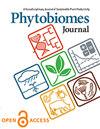Changes in fungal and oomycete community composition following irrigation reductions aimed at increasing water use efficiency in a containerized nursery crop
IF 2.6
3区 生物学
Q2 MICROBIOLOGY
引用次数: 1
Abstract
Ornamental production in the U.S. spans an estimated 267,000 hectares and uses approximately 169,000 m3 of water yearly. Ornamental growers, particularly those with air-closed systems, are interested in implementing reduced irrigation technologies like sensor-controlled irrigation (SCI) systems to improve water use efficiency in response to water scarcity. To evaluate phytobiome impacts, we utilized an Illumina metabarcoding approach to characterize changes in fungal and oomycete rhizosphere communities of commercially grown poinsettia, complementing previous studies of single-pathogen impacts. Minor reductions (from 54% volumetric water content [VWC] to 50% VWC) did not have large effects on rhizosphere fungal community structure, but shifts in plant health status (symptomatic/ asymptomatic) correlated with shifts in fungal diversity and evenness, with an increased abundance of several taxa including Plectosphaerella cucumerina, and Fusarium sp. in symptomatic plants. Further reductions in irrigation (45% VWC, 35% VWC and 25% VWC) did not affect overall fungal community composition, but the lowest VWC increased the abundance of potential root rot pathogens like Phoma multirostrata and Plectosphaerella cucumerina. Reduced irrigation volumes decreased oomycete diversity and abundance of several known pathogens in the Phytophthora genus. Addition of a bacterial product (Companion®) with putative pathogen suppressive and drought-tolerance enhancing effects had no influence on fungal community composition or abundance, but increased abundance of some oomycete species at 45% VWC. This study shows that adoption of reduced irrigation may have greater effects on fungal vs. oomycete taxa in the system, with consistent patterns of fungal enhancement, including putative fungal pathogens and beneficial organisms, and oomycete suppression.减少灌溉以提高容器化苗圃作物的水分利用效率后真菌和卵菌群落组成的变化
美国的观赏种植面积约为26.7万公顷,每年使用约16.9万立方米的水。观赏种植者,特别是那些采用密闭系统的观赏种植者,对实施传感器控制灌溉(SCI)系统等减少灌溉技术感兴趣,以提高水的利用效率,以应对水资源短缺。为了评估植物群落的影响,我们利用Illumina元条形码方法来表征商业种植一品红根际真菌和卵菌群落的变化,补充了先前对单一病原体影响的研究。少量减少(从54%的体积含水量降至50%)对根际真菌群落结构没有太大影响,但植物健康状态(有症状/无症状)的变化与真菌多样性和均匀性的变化相关,在有症状植物中,黄瓜Plectosphaerella cucumerina和镰刀菌(Fusarium sp.)等几个分类群的丰度增加。进一步减少灌溉量(45%、35%和25%)对真菌群落的总体组成没有影响,但最低的灌溉量增加了潜在的根腐病病原体如多刺蚜和黄瓜斑孢菌的丰度。灌溉量的减少降低了疫霉属中卵菌的多样性和几种已知病原体的丰度。添加具有抑制病原菌和增强耐旱性作用的细菌产物(Companion®)对真菌群落组成和丰度没有影响,但在45% VWC时增加了某些卵菌种类的丰度。本研究表明,采用减少灌溉可能对系统中真菌和卵菌类群有更大的影响,真菌增强的模式一致,包括假定的真菌病原体和有益生物,以及卵菌抑制。
本文章由计算机程序翻译,如有差异,请以英文原文为准。
求助全文
约1分钟内获得全文
求助全文

 求助内容:
求助内容: 应助结果提醒方式:
应助结果提醒方式:


